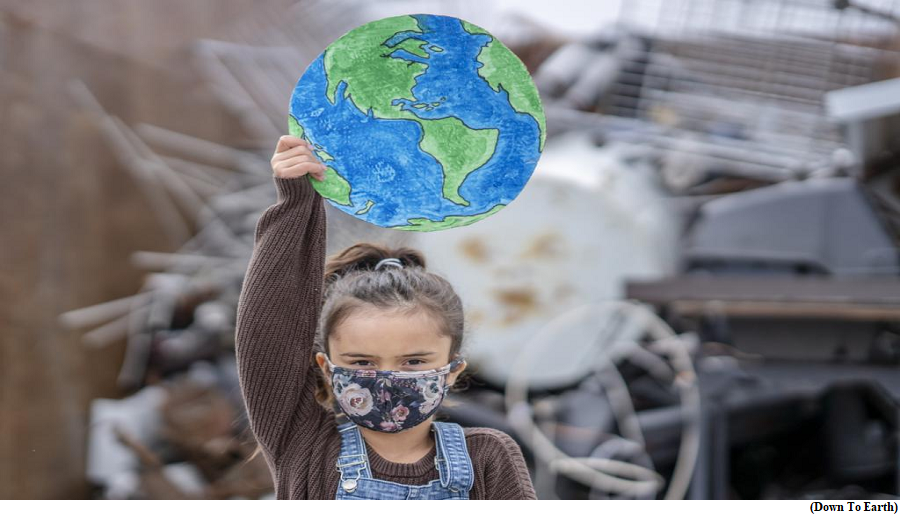First-of-its kind UN guidance calls for climate action by States to protect children’s rights (GS Paper 3, Environment)

Why in news?
- For the first time, the United Nations has recognised and affirmed children’s rights to a clean, healthy and sustainable environment in a new guidance on children’s rights and the environment, with a special focus on climate change.
Details:
- The new guidance, formally known as General Comment No. 26, was adopted on August 28, 2023.
- It provides a legal framework to address the adverse effects of environmental degradation and climate change on the enjoyment of children’s rights and to ensure a clean, healthy, and sustainable world now and to preserve it for future generation.
UN convention on rights of the child:
- In 1989, the UN convention on rights of the child outlined children’s rights, which includes the right to life, health, clean drinking water and survival and development.
- It has been ratified by 196 countries.
Stakeholders:
- The efforts of children to draw attention to these environmental crises motivated the UN Committee on Rights of the Child to come out with the 20-page document.
- The document was adopted after two rounds of consultation with UN member states, national human rights institutions, international organizations, civil society, thematic experts and the children too.
- Children from at least 121 countries had shared and reported on the negative effects of environmental degradation and climate change on their lives and communities.
- They asserted their right to live in a clean, healthy and sustainable environment stated the UN Human Rights office of the high commissioner in a statement.
Key Guidelines:
- The UN member states have been asked to take all necessary, appropriate and reasonable measures to protect against harms to children’s rights related to climate change that are caused by businesses.
- Nations have been urged to equitably phase out the use of coal, oil and natural gas. They have also been asked to ensure a fair and just transition of energy sources and invest in renewable energy, energy storage and energy efficiency to address the climate crisis.
- Establishing inclusive early warning systems must be a priority of all the nations to protect children from impacts of the extreme weather events.
- Echoing the concerns of voices on developing countries on gaps in climate finance, the UN child rights committee has also urged upon the developed countries to provide grants rather than loans for actions to avoid negative impacts on children’s rights.
- It has voiced its concerns over the unequal share of finances provided for adaptation and loss and damage measure.
Concerns:
- The future of children around the world including India, is being threatened by environmental degradation and climate change, alerted WHO-UNICEF-Lancet in a 2020 report.
- So, ahead of the 28th Conference of Parties (COP28) to the UN Framework Convention on Climate Change, the UN document reminded that insufficient progress in achieving international commitments to limit global warming exposes children to hazards associated with greater concentrations of greenhouse gas emissions, which includes rising temperature.
- Reducing carbon emissions can prevent 4,000 to 6,000 child deaths due to heat in Africa every year. In 2022, extreme weather events around the world displaced at least 12 million children in 2022.
Way Forward:
- Adaptation frameworks should address climate change-induced migration and displacement and include provisions for ensuring a child rights-based approach to these issues.
Reroute rail track through gibbon sanctuary
(GS Paper 3, Environment)
Why in news?
- Primatologists have suggested rerouting a 1.65-km long railway track that has divided an eastern Assam sanctuary dedicated to the western hoolock gibbon (Hoolock hoolock) into two unequal parts.

Artificial canopy bridge:
- Their report follows that of the Wildlife Institute of India (WII) on designing an artificial canopy bridge to facilitate the movement of the hoolock gibbons across the broad-gauge line within the Hollongapar Gibbon Sanctuary. The track is yet to be electrified.
Why it matters?
- The sanctuary has become a ‘forest island’, having lost connectivity with surrounding forest patches. Since gibbons are exclusively arboreal animals inhabiting the forest’s upper canopy, they are particularly sensitive to canopy gaps.
- Gibbon families on both sides of the railway track have thus been effectively isolated from each other, thereby compromising their population’s genetic variability and further endangering their already threatened survival in the sanctuary.
About hoolock gibbons:
- Housing about 125 hoolock gibbons, India’s only ape, the sanctuary in the Jorhat district covers an area of 21 sq. km.
- Like the other 19 gibbon species on earth, it is marked endangered due to habitat loss and habitat fragmentation.
Threat:
- The current population of hoolock gibbons is estimated to be around 12,000 individuals.
- They are found in forested areas of Northeast India, Bangladesh, Myanmar and Southern China.



